Wisconsin Dells, Wisconsin
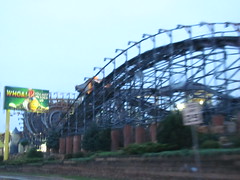 We had originally planned to do Timber Falls Adventure Park on the second evening in the Dells after the Wisconsin Ducks tour had finished, but by the time we got there a light drizzle had turned into a steady downpour with no sign of letting up and all we could do was drive by and think how good it felt to be dry. Even if I had been willing to get very wet and cold, the prospects for any decent photos seemed nil. The previous time we were here we had allocated nearly an entire day just to Timber Falls which allowed for more coaster rides and mini golf games than should have been necessary. So we decided the best plan of action should be to do nothing, especially since prices have gone up and I have heard that time has not been so kind to the wooden track. I’m noticing a trend for wooden coasters located in the Dells.
We had originally planned to do Timber Falls Adventure Park on the second evening in the Dells after the Wisconsin Ducks tour had finished, but by the time we got there a light drizzle had turned into a steady downpour with no sign of letting up and all we could do was drive by and think how good it felt to be dry. Even if I had been willing to get very wet and cold, the prospects for any decent photos seemed nil. The previous time we were here we had allocated nearly an entire day just to Timber Falls which allowed for more coaster rides and mini golf games than should have been necessary. So we decided the best plan of action should be to do nothing, especially since prices have gone up and I have heard that time has not been so kind to the wooden track. I’m noticing a trend for wooden coasters located in the Dells.
Nevertheless, one of the main reasons I planned on a return trip to the Dells in the first place was because I really wanted to get a Timber Falls review out of it. I mean, surely no one thinks I’d go to Wisconsin just for my own personal gratification, right? So what the hellcat, even though I don’t have new photos I’ll write one anyway based on my last trip from 2005, when I had more than enough time to get an impression of the place to last a lifetime. Just excuse the low-quality pictures, please. 2005 was long, long ago in technology years…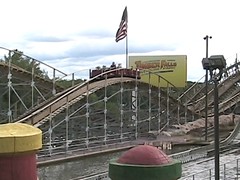
Timber Falls has an interesting business model that I’m disappointed hasn’t been replicated at more locations across the country. Not an amusement park, but more substantive than a typical FEC, Timber Falls’ strategy has been to find a niche base market, and then strategically expand with reasonably major theme park rides that gives it a competitive advantage while keeping operations small and economical. With just a coaster, log flume, and four minigolf courses included in the price of a one-day admission ticket, Timber Falls found a way to become a half-day destination without requiring the huge overhead of similar regional amusement parks which require large staffing and related facilities to handle the plethora of smaller supporting attractions that eat into operational expenses. It seems like a logical upwards progression from the Pirate’s Cove franchise found next door, and ever since my first visit I always wished more towns (i.e. my hometown) would look at Timber Falls and install something similar for themselves.
that eat into operational expenses. It seems like a logical upwards progression from the Pirate’s Cove franchise found next door, and ever since my first visit I always wished more towns (i.e. my hometown) would look at Timber Falls and install something similar for themselves.
Well, reflecting on it today it’s possible they did look at Timber Falls and weren’t particularly impressed. For reasons I still can’t quite comprehend the place simply never found its audience, and business has been so bad that there were rumors (that may still persist) that the owners wanted to dismantle the wooden coaster for scraps and to relieve themselves of nightmarish maintenance costs. Apparently a single 3-car PTC train does some significant damage to the track, so much so that on many days the combined expenses associated with track and train upkeep and repairs, as well as staffing and utilities, meant that the coaster operated at a loss even after ride tickets were figured in. Hence the implementation of a maximum five ride per daily ticket policy, which I doubt helps attract many new patrons; perhaps requiring a full train or a 15 minute waiting period before dispatching could be a better solution that wouldn’t automatically lower the face value of the tickets for the few coaster crazies that still visit the place?
the combined expenses associated with track and train upkeep and repairs, as well as staffing and utilities, meant that the coaster operated at a loss even after ride tickets were figured in. Hence the implementation of a maximum five ride per daily ticket policy, which I doubt helps attract many new patrons; perhaps requiring a full train or a 15 minute waiting period before dispatching could be a better solution that wouldn’t automatically lower the face value of the tickets for the few coaster crazies that still visit the place?
With the wooden coaster in only its second year of operation and the skies bright and clear on a radiant July afternoon, the future seemed far more promising on in 2005. Rather than jump right on the coaster after buying our wristbands, my dad and I took our time and played a round of the minigolf located inside the coaster’s triangular layout. It had this tantalizing quality, casually lining up my putter for a calm round of golf, and all the while a brand new wooden hybrid coaster (supposedly a top ten ride for several individuals) would occasionally haul around the track, steel wheels screeching and rattling only several yards away. We held our cool even long enough to sample the park’s other large mechanical attraction, the Timber Wolf Log Flume. This was a much better flume than I expected from a park this size, with two drops (the first a small teaser at the beginning of the layout, and the second the big, dramatic finale) and a sizable trough section around the minigolf course and through an elf-infested tunnel. Yet as sweet (and even – dare I say it – erotic) as the unfulfilled
took our time and played a round of the minigolf located inside the coaster’s triangular layout. It had this tantalizing quality, casually lining up my putter for a calm round of golf, and all the while a brand new wooden hybrid coaster (supposedly a top ten ride for several individuals) would occasionally haul around the track, steel wheels screeching and rattling only several yards away. We held our cool even long enough to sample the park’s other large mechanical attraction, the Timber Wolf Log Flume. This was a much better flume than I expected from a park this size, with two drops (the first a small teaser at the beginning of the layout, and the second the big, dramatic finale) and a sizable trough section around the minigolf course and through an elf-infested tunnel. Yet as sweet (and even – dare I say it – erotic) as the unfulfilled temptation of a new wooden coaster so close by had been, we could no longer hold off. It was time to ride the Avalanche!
temptation of a new wooden coaster so close by had been, we could no longer hold off. It was time to ride the Avalanche!
(Or the Hellcat as it has since become known; I don’t know if the name makes any difference since there’s virtually no reference to it anywhere except for the website and ticket booth. This also strangely marks the second of S&S Power’s four wooden coasters they built to have changed their names from a weather disaster to Hellcat. I have to think they had something to do with one another and it wasn’t just random chance. Maybe when Timber Falls heard about their sister coaster’s new name they thought, “I didn’t know we could say ‘hell’ on a roller coaster! (Giggles.) Cool, I wanna do that too!” Or maybe the coaster’s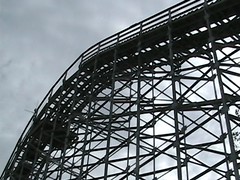 state license plate needed renewal, and rather than buy a new piece of engraved metal they bought one used off of their supplier. Who knows, right?)
state license plate needed renewal, and rather than buy a new piece of engraved metal they bought one used off of their supplier. Who knows, right?)
We ended up riding Avalanche close to twenty-five times that day. We had planned to get to thirty, but returning to the coaster after a late-night minigolf game we found that apparently everyone else in the park had left and so they shut the ride down nearly an hour and a half before the official closing. (The odd thing was we could still walk right up into the dark and empty station, and Timber Falls is an open admission park. I really have no idea how they didn’t have a problem with vandals.) It is a very fun, reridable coaster that was just about perfect for the park. Plenty of airtime over all the hills and a consistently lively pace from start to finish,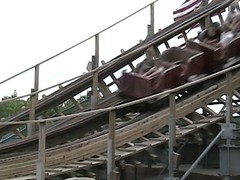 although as I recall even back then the turns had some problems with uncomfortable shuffling. From what I’ve heard it’s gotten much rougher today.
although as I recall even back then the turns had some problems with uncomfortable shuffling. From what I’ve heard it’s gotten much rougher today.
Yet even running at its best, I never fell head-over-heels in love with the spunky little coaster as some people had. It struck me as too limited and repetitious an experience, consisting only of airtime and mandatory curves. When I started this website a few years later, one of the first big questions I raised was whether G-forces by themselves were sufficient to make a good ride, and I responded with a resounding “no”. Just as the nearby Zeus and Cyclops got me thinking more deeply about storytelling and sequencing in a ride, Avalanche was a primary influence on my decision to study coaster aesthetics more rigorously than simply counting off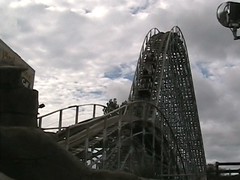 the moments of airtime as many who praised it had done. So in a weird way, I retain some sentimental affiliation with the coaster for the very reasons I found it overrated.
the moments of airtime as many who praised it had done. So in a weird way, I retain some sentimental affiliation with the coaster for the very reasons I found it overrated.
And I sort of wanted to return because, looking back on the layout with a few more years of theory developed, I found there was more to like than I originally gave it credit for. At first I wanted every coaster to be very dramatically structured with a big finish, but I’ve since learned to find that a layout consisting of repetition with careful variation can often yield even greater rewards. Avalanche basically consists of two triangular circles around the park perimeter. The first three sides of the outer triangle all contain one airtime hill before alternating with a left-hand curve, while the sides of the inner triangle all have two smaller pops of airtime. Even a couple of the turns have a few distinguishing characteristics that act as good progression signifiers. The turn that transitions from the outer triangle to the inner is flatter and lasts a couple beats longer than the others; this is a perfect midpoint bridge. And the final turnaround over the entrance pathway has a small banked airtime hill at the top, a surprise variation in dynamics for the finish that mixes the two previously separated sensations the layout alternates between. Plus, as I said before, it’s just a fun layout. I sometimes get so wrapped up in analysis that I forget that “fun” still counts for something in a coaster.
while the sides of the inner triangle all have two smaller pops of airtime. Even a couple of the turns have a few distinguishing characteristics that act as good progression signifiers. The turn that transitions from the outer triangle to the inner is flatter and lasts a couple beats longer than the others; this is a perfect midpoint bridge. And the final turnaround over the entrance pathway has a small banked airtime hill at the top, a surprise variation in dynamics for the finish that mixes the two previously separated sensations the layout alternates between. Plus, as I said before, it’s just a fun layout. I sometimes get so wrapped up in analysis that I forget that “fun” still counts for something in a coaster.
A significant amount of time was spent sampling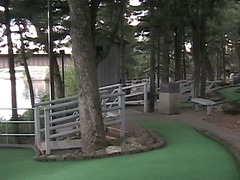 the remaining three mini-golf courses on the opposite side of the park. Similar to Kentucky Kingdom, Timber Falls is split into two parts across Stand Rock Road (only there’s no bridge to deal with; you just have to look both ways to get from one side to the other), and the difference between each side is kind of surprising. While the main side with the rides and first minigolf course has some pretty elaborate eye-candy, the older original side with the other three courses is very rustic and natural. There’s essentially nothing there except for 54 minigolf holes scattered beneath the trees along the banks of the Wisconsin River. It was quite tranquil, and after extended time on the coaster it made for a perfect forty-five minute retreat from the noise and chaos, by which time when we’d finished we’d be plenty ready for more Avalanche riding.
the remaining three mini-golf courses on the opposite side of the park. Similar to Kentucky Kingdom, Timber Falls is split into two parts across Stand Rock Road (only there’s no bridge to deal with; you just have to look both ways to get from one side to the other), and the difference between each side is kind of surprising. While the main side with the rides and first minigolf course has some pretty elaborate eye-candy, the older original side with the other three courses is very rustic and natural. There’s essentially nothing there except for 54 minigolf holes scattered beneath the trees along the banks of the Wisconsin River. It was quite tranquil, and after extended time on the coaster it made for a perfect forty-five minute retreat from the noise and chaos, by which time when we’d finished we’d be plenty ready for more Avalanche riding.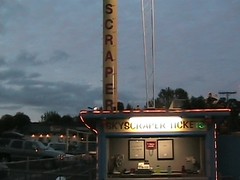
We did leave the park once in the early evening to get dinner. When we returned we decided that it would be irresponsible to have spent so much time in such a small park and never once try the intimidating Sky Scraper. It was an upcharge attraction which caused a few minutes of debate, but since we were entitled to a 50% discount with our all-day wristbands we decided that there was unlikely to ever be a more perfect opportunity to try one. We were quite glad we did. This thing was crazy intense. It’s basically a giant arm with two seats attached to either end that rotates like a high velocity Ferris Wheel. While it was easy to describe it superficially as high speed from the ground, what I didn’t realize was that we would receive several seconds of powerful sustained negative G-forces over the entire upper arc of the radius, with virtually nothing to obstruct the view. And experiencing that in person: as I said, crazy intense. Think of the biggest and strongest negative-G airtime hills on any coaster, remove the track and supports from around you, and repeat thirty or so times in a five minute cycle. Going backwards was even wilder because the seats felt like they were going to flip us upside-down behind us as we crested the top. The ride was raw adrenaline, not exactly the highest of pleasures, but we liked it so much my dad contemplated paying to ride it again. And if you ever knew how cheap my dad is, that’s an endorsement of the very highest order.
of powerful sustained negative G-forces over the entire upper arc of the radius, with virtually nothing to obstruct the view. And experiencing that in person: as I said, crazy intense. Think of the biggest and strongest negative-G airtime hills on any coaster, remove the track and supports from around you, and repeat thirty or so times in a five minute cycle. Going backwards was even wilder because the seats felt like they were going to flip us upside-down behind us as we crested the top. The ride was raw adrenaline, not exactly the highest of pleasures, but we liked it so much my dad contemplated paying to ride it again. And if you ever knew how cheap my dad is, that’s an endorsement of the very highest order.
But this time we didn’t ride the Sky Scraper,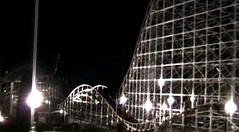 we only glanced at it standing still through the shimmering rain, and then turned the car around to go back to the hotel for a rest before a final late night at Mt. Olympus when the weather would clear. We both agreed this was a far better use of time. How the times have changed.
we only glanced at it standing still through the shimmering rain, and then turned the car around to go back to the hotel for a rest before a final late night at Mt. Olympus when the weather would clear. We both agreed this was a far better use of time. How the times have changed.
There isn’t much of a narrative to Hell Cat is there? Never thought about it. It’s fun, fast and I can’t get enough of lateral air. I am going to have to get on a Sky Scraper, I had no idea they were like you described with pure air over the the top arc. That sounds worth it.
Steve, how recently have you been on Hellcat? Has it gotten really rough or does it still manage to give a decent ride? I’m still a little bit bummed I missed out on it this year.
The Sky Scraper’s worth it if you’ve never done one before. I think now it’s about $11 with an all day pass. The ratio of expense to value is much better than any of the upcharge rides at Mt. Olympus.
I rode Hellcat last weekend. It can be a little rough. I had rode it three weekends ago when it lightly rained and it rode very smoothly then! When I went last weekend it had not rained and the ride can be somewhat rought depending on where you are sitting and how many people are on the ride.
Right now the ride costs $6.50 per ride or you can buy an all day pass for $19.99, which includes up to ( 5 ) ride on Hellcat. From 5 p.m. to their closing time at 10 p.m. you can get the braclet for $14.99.
The operator of the ride was amazed at why I had gone on Hellcat so much. She said she would never get on the ride again as it’s very rough. If you want rough try the Boss at the Six Flags in St. Louis!
I would give this rollercoaster an 8/10. It’s one of my favorite wooden roller coasters. It’s a shame that it’s pretty much a hidden gem. There isn’t anything about the roller coaster on Wiki!